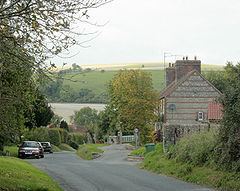OS grid reference ST856373 Sovereign state United Kingdom Dialling code 01985 Post town Warminster | Unitary authority Postcode district BA12 | |
 | ||
Monkton Deverill (anciently known as East Monkton) is a village and former civil parish in Wiltshire, England, about five miles south of Warminster and four miles northeast of Mere. It stands on the River Wylye and forms part of a group of villages known as the Upper Deverills.
Contents
Map of Monkton Deverill, Warminster, UK
History
Two Roman roads intersect close to the village. In 1989–1990, archaeologists investigated a 7th-century Anglo-Saxon cemetery in the parish and also made a section through a Roman road.
Before the Dissolution of the Monasteries, Monkton Deverill was a manor of Glastonbury Abbey and was formerly known as East Monkton. In the Middle Ages, its church was a chapel of the church at Longbridge Deverill, also a Glastonbury manor.
For almost forty years, beginning in the late 14th century, the bailiffs of Glastonbury Abbey's manors of Longbridge and Monkton Deverill, which were remote from the Abbey's own logistical systems, kept good accounts of their stewardship. These records survive and provide detailed information on the manors' agricultural and other business. They show that most of the grain produced on the land went to markets within ten miles, except in years when it was selling for higher prices. Most buyers of the manors' wool came from within a radius of twenty miles. However, some items, such as millstones, were brought from much farther away.
After the Dissolution, the manor was sold by the Crown to John Thynne together with Longbridge Deverill and thereafter descended in his family, who much later became Marquesses of Bath. The Thynnes have preserved many of Glastonbury Abbey's records at Longleat up to the present day.
The village's later history centres on its former Church of England parish church, dedicated to St Alfred the Great. Alfred had marched into the valley of the Deverills in 878, on his way to victory at the Battle of Ethandun.
In 1845, most of the church was demolished, leaving only the 14th-century tower standing, and rebuilt under the direction of Thomas Henry Wyatt.
The Gentleman's Magazine noted in January 1846
November 25. [1845] The church of Monkton Deverill was re-opened for divine service, after having been closed for some time. The church was in a state of such extreme dilapidation, that scarcely could the parishioners meet together in safety from the dangerous condition of the aisles and roof. The Trustees of the Marquess of Bath, to whom the larger part of the parish belongs, have contributed 400l towards the repairs; and the occupiers cheerfully passed a church-rate of about 118l which nearly covered the remaining expenses. The old building was levelled to the ground, with the exception of the tower, and rebuilt from the designs of the diocesan architect, Thomas Wyatt, esq. It is built in the plain perpendicular style; the eastern window alone having any peculiar tracery. The roof is of open timber, stained to imitate oak. The sittings are open, with square stall heads. The eastern window is of stained glass, by Millar, and the gift of the rector, the Rev. Lord Charles Thynne.
The new church contained a fine pulpit, believed to be originally from Belgium, also presented in the mid 19th century by the Rev. Lord Charles Thynne, rector of the parish. In 1928, Edward Hutton noted
Kingston Deverill looks better than it is – Monkton Deverill, not a mile lower down the valley, has, however, even less to show. Of the church only the Perpendicular tower and the Norman font are old, though here again the pulpit panels representing scenes from the Old Testament are interesting.
The church was made redundant in 1970 and has since been converted into a private house. The parish registers are now held in the Wiltshire and Swindon History Centre and cover the periods 1695–1961 (baptisms), 1749–1958 (marriages), and 1740–1980 (burials).
The population of the parish was 204 in 1831, but is now lower.
A detailed parish history is in progress and will be published as part of volume XIX of A History of the County of Wiltshire.
Governance
Almost all significant local government services are now provided by Wiltshire Council, a unitary authority created in 2009, which has its main offices in Trowbridge. The village is represented in parliament by Dr Andrew Murrison and in Wiltshire Council by Fleur de Rhé-Philipe, both Conservatives.
